BR(W) loco-hauled coach livery 1948–1964
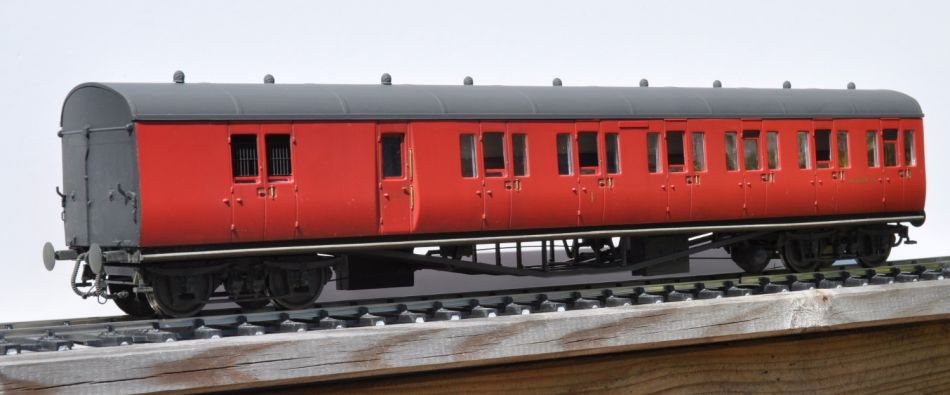
Ian Hall's lightly weathered Lionheart crimson E140 brake composite, with most droplights altered to be open

Nidge Ratledge's nicely weathered Hornby Hawksworth brake composite
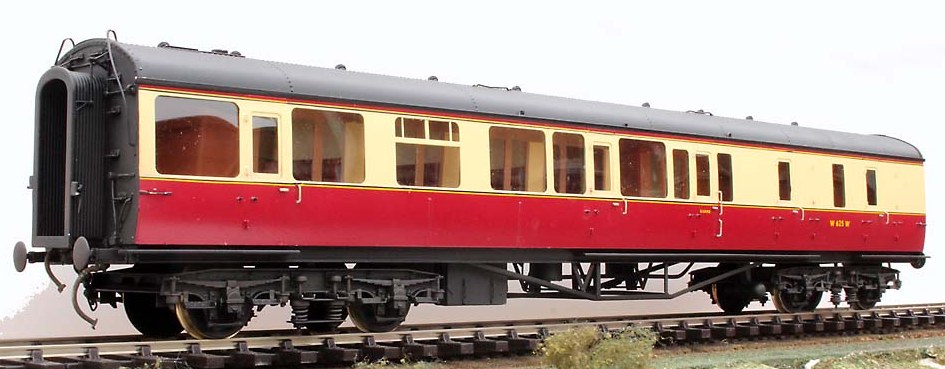
Larry Goddard's 7mm Brake 3rd D127, from a SanCheng unpainted product, with some underframe detail, seats and glazing. Shown here before the corridor handrail was fitted.
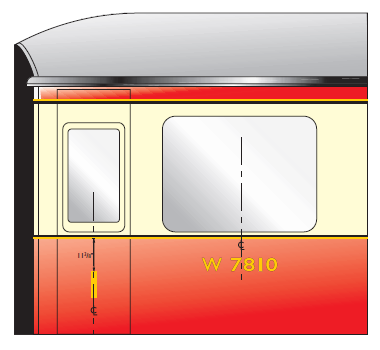
Pete Speller's downloadable pdf, produced from the notes of L J Baugh, who worked in the Swindon Drawing Office, gives full details of the first BR livery applied to GWR stock from 1949–1951.
Please note this pdf has been updated (11 June 2013) to clarify the position of the waist lining with respect to the bottom of the windows.
| The contrast between crimson and maroon |
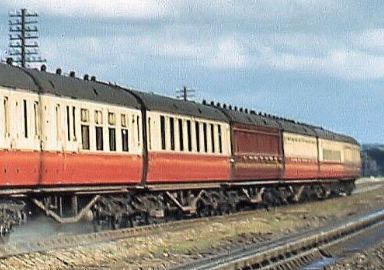 |
BR crimson is difficult to define, and tended to fade in service. (Both coaches in the adjacent picture are in crimson.)
This colour gradient, from left to right, is an approximation of new to faded crimson.
The colour is often referred to as carmine, which traditionally is a very bright red.
It is likely there were variations in the paint colour used in different coach workshops. |
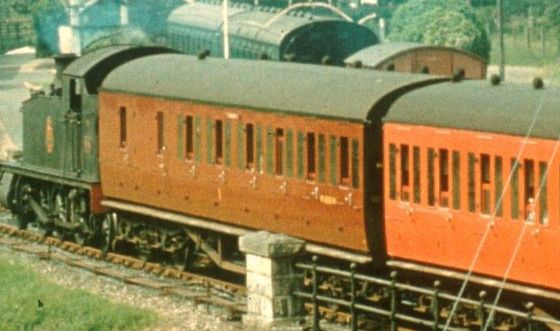 |
The following timeline table gives the liveries applied to newly-painted stock. Given the typical time period between repaints, many GWR coaches continued on in their pre-WWII state, except for the deletion of the GWR insignia, for many years until they eventually caught up with the 1949 crimson-based livery schemes. Most GWR-built corridor stock however did receive the crimson and cream livery, but comparatively few would survive to receive the later lined maroon livery, and only three Hawksworth SK coaches (W1719W, W2135W and W2283W) would survive to carry the 1965 BR blue and grey livery. Some non-corridor stock lasted until the end of steam.
My thanks to the late Chris Foren for help in compiling these notes.
| Date |
Livery notes |
| 1948 |
After nationalisation, coaches of GWR designs continued to be built. Initially, coaches were outshopped in the previous post-WWII livery except that the G W R insignia was omitted and a 'W' was added as a prefix to the coach number.
An experimental 'plum and spilt milk' livery was introduced in 1948 for some corridor stock.
An unlined 'wine red' livery was introduced in 1948 for the City suburban sets, and some Birmingham suburban coach sets.
Brake composites 7372/7 were turned out in GWR livery in 1948 for continuity with special trains, and kept in that condition until receiving BR(W) brown and cream in 1956. The seven Q13 Inspection Saloons were also outshopped in GWR livery. |
| 1949 |
In 1949, crimson and cream livery was introduced for corridor stock, and lined all-over crimson for non-corridor stock. Autotrailers were also painted in crimson and cream, but the size of the lettering appears to have varied – 7" high numbers on left-hand end of each side only and a smaller size of lettering at the right-hand end of each side only.
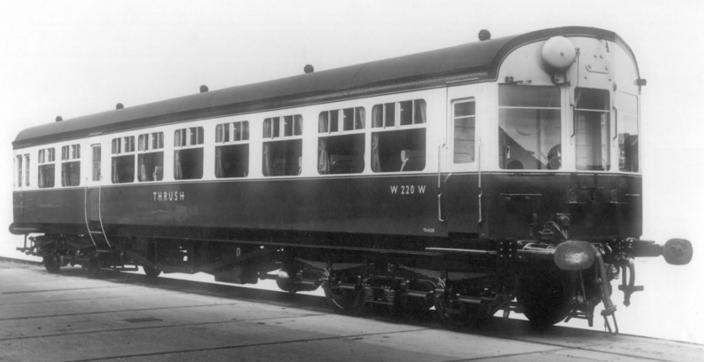
|
| 1951 |
In May 1951, an order was issued that coach numbers were in future to be applied only to the right-hand end (previous BR liveries having had them at the left-hand end). GWR designs continued to carry numbers at the left-hand end, but right-hand end numbers became more common during 1952. |
| 1952 |
From c 1952, lining on all-over crimson stock was discontinued.
In July 1952, BR issued an instruction that autotrailers were be considered as 'local stock', and that they should therefore be outshopped in plain all-over crimson.
In addition to the W prefix, a W suffix was added to coach numbers on GWR designs. This process was very gradual, and coaches could still be seen without suffixes in 1956. |
| 1956 |
Brown and cream was re-introduced for some BR MkI corridor stock for certain trains, and some GWR-design vehicles (restaurant cars, slip coaches, and the Super Saloons) working with those coaching sets were repainted in the livery. The remainder of GWR-design corridor stock began to be outshopped in lined maroon, and non-corridor stock began to be outshopped in unlined maroon.
The lining for the lined maroon was black-yellow-black at the waist, and black-yellow at the cantrail: however, some lined maroon vehicles did not have any lining at the cantrail. |
| 1959 |
Lined maroon was extended to non-corridor stock, and first appeared mid-1959. |
| 1961 |
Although not in the strict scope of 'loco-hauled' stock, three Hawksworth composites (W7254W, W7804W and W7813W) were painted brunswick green in late 1961 to augment Gloucester Cross-Country (later to be Class 119) DMU sets, although the latter were still in an earlier lighter malachite green at the time. |
| 1962 |
The decision to abandon brown and cream was taken c April 1962, although it took quite a long time for such stock to reappear in maroon. |
General |
Coaches of GWR design did not display any BR insignia, with the exception of some slip coaches re-liveried in 1956 to chocolate and cream, although it is likely the BR 1956 roundel was not applied until considerably after 1956.
Droplights were painted the same colour as their adjacent bodywork, i.e. cream, crimson, maroon or green.
Coach roofs were mid grey, somewhat lighter than used at the end of the GWR era.
The GWR diesel railcars carried a variety of liveries: crimson ('carmime') and cream, all-over crimson, and BR multiple unit green. Collett C77 Open Third W1096W was repainted in BR multiple unit green to work with the diesel railcar twin unit W33W + W38W. |
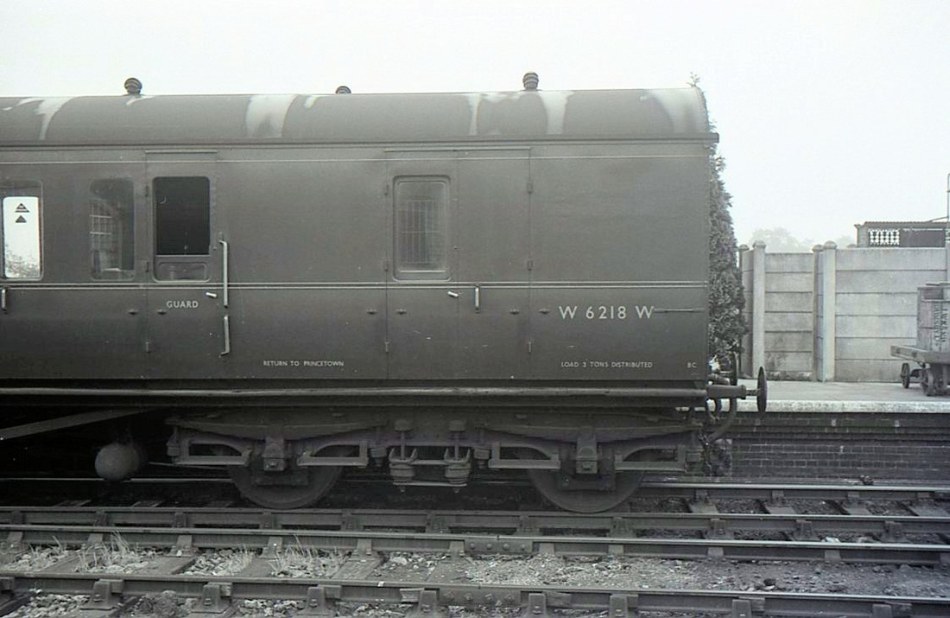
The lettering 'BC' at the foot of the side denotes Brake Composite. Other vehicles were marked accordingly. Lettering at the foot of sides was not part of the 1949–51 painting specification, and seems to have been introduced in the post-1956 maroon period. W6218W is an E157 brake composite (of a single batch of 20). E157 was similar to the E147 but had two first class compartments (E147 had only one), slightly deeper windows, slightly flatter sides, unrecessed guards doors, and had conventional buffers at the non-brake end, and generally worked as singles, so were not official 'B-sets'.
|







